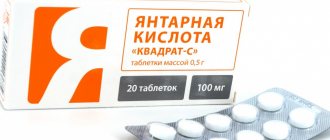Thioctic acid: antioxidant therapy for neurological diseases
The use of thioctic acid in medical practice is largely associated with the development of ideas about “oxidative stress” and lipid peroxidation as a fairly universal pathogenetic mechanism of cell and tissue damage [24]. The antioxidant effect of thioctic acid is due to the presence of two thiol groups in the molecule (hence the prefix “thio”), as well as the ability to bind free radicals and free tissue iron (preventing its participation in lipid peroxidation) [10]. Thioctic acid not only has independent antioxidant potential, but also provides powerful support for the work of other antioxidant units in the body [23]. In this regard, its protective effect is closely related to homeostasis in the glutathione and ubiquinone system [8]. The production of reactive oxygen species increases significantly with inflammation, immunological disorders, hypoxia, hyperoxia, exposure to drugs, radiation, and antioxidant deficiency.
Thioctic acid is one of the most powerful antioxidants used in the treatment of diabetic neuropathy [2, 25]. Thioctic acid is a coenzyme of key enzymes in the Krebs cycle, which explains its effectiveness. An additional advantage in the mechanism of action of thioctic acid is its clearly documented effect of glucose utilization [15]. The high efficiency and pathogenetic effect of thioctic acid have been proven by numerous experimental and clinical studies. The adequate and rational use of thioctic acid preparations is based on the results of numerous studies (ALADIN I, ALADIN II, ALADIN III, ORPIL, NATHAN, DECAN, SYDNEY), which tested the dose, frequency of administration and course duration (Table 1).
A multicenter, randomized, double-blind study (SYDNEY II) assessed the effectiveness of thioctic acid in the treatment of patients with diabetic polyneuropathy (DPN) [1, 3]. The study was conducted from 2004 to 2006, it involved 87 patients with diabetes mellitus (DM) of type 1 and 2, who were undergoing inpatient (National Healthcare Institution Central Clinical Hospital No. 1 of JSC Russian Railways) and outpatient treatment (Department endocrinology of the State Educational Institution of Additional Professional Education of the Russian Medical Academy of Postgraduate Education (Roszdrav). The SYDNEY study concluded that intravenous alpha lipoic acid for 3 weeks. causes a significant reduction in neuropathic symptoms and neurological objective symptoms that are painful for patients. Considering the dose-dependent effect of side effects, the optimal dosage is 600 mg of thioctic acid. The authors concluded: as a result of a comprehensive clinical and neurophysiological study of patients with type 1 and type 2 diabetes, it was noted that the earliest EMG indicator of sensory nerve damage in diabetes is a decrease in the action potential. Pain reduction occurred from the 2nd week. taking thioctic acid at a dose of 1800 mg/day, from the 4th week. reception - at a dose of 1200 mg and only by the 5th week. - while taking 600 mg of thioctic acid [3]. In patients with DPN (n=24) participating in the study, using thioctic acid at a dose of 1800 mg/day for 3 weeks. neuropathic symptoms and neurological deficits decreased; the incidence of side effects was comparable to the placebo group [29].
In medical practice, a number of thioctic acid preparations are used for therapeutic purposes, which are represented by its three main salts: ethylenediamine, trometamol and megluminic [12]. One of the drugs whose active substance is thioctic (alpha-lipoic) acid is Thiogamma® (pharmaceutical (Germany)). Thiogamma® is a meglumine salt of alpha-lipoic acid, polyethylene glycol is used as a solubilizer, their advantages are to suppress the formation of free radicals, improve the energy metabolism of neurons, and restore impaired endoneurial blood flow. The drug is available in the form of tablets containing 600 mg of the drug, a solution for intravenous infusion in bottles containing 600 mg of the drug in the form of meglumine salt, and ampoules. Meglumine (N-methyl-D-glucamine) is known to be used as a stabilizer in many pharmaceutical products [12]. Meglumine is also used to reduce the toxicity of gadolinium in magnetic resonance contrast media. It is used as the antimonate meglumine to treat leishmaniasis. It was demonstrated that in the experiment, mice accepted a dose of up to 1 g/kg when administered intraperitoneally without side effects. There is only one report of the development of an anaphylactic reaction in a patient with osteoid osteoma after the use of gadoteric and gadopentetic acid during an MRI study. No descriptions of other negative effects of meglumine could be found. Thus, we can conclude that of all the stabilizers used for the manufacture of dosage forms of thioctic acid, meglumine is the least toxic.
Instructions for use of the drug Thiogamma® were approved on 04/15/1999 by the State Pharmacological Committee of the Ministry of Health of Russia, re-registration on 05/24/2010 (for tablet forms), 02/29/2012 (for injection forms) [19]. The drug is prescribed 1 r./day 300–600 mg, taken without chewing, with a small amount of liquid. According to the ALADIN I study [28], the effect of alpha-lipoic acid on positive neuropathic symptoms at doses of 600 and 1200 mg is practically the same. In a clinical study of 3 weeks of intravenous alpha-lipoic acid, side effects (headache, nausea, vomiting) were more common with 1200 mg (32.6%) than with 600 mg (19.8%) with placebo. (20.7%) [28]. It was concluded that a dosage of 600 mg of alpha-lipoic acid is optimal both from the point of view of clinical effectiveness and taking into account the possibility of developing side effects.
The clinical use of thioctic (alpha-lipoic) acid (in particular, Thiogamma®) is based on the many biochemical and physiological effects of this substance [6]. The main mechanisms of action of Thiogamma®, according to those set out in the Methodological Recommendations of V.V. Gorodetsky (2004) [8], can be presented as follows:
- influence on energy metabolism, glucose and lipid metabolism (participation in the oxidative decarboxylation of keto acids) with activation of the Krebs cycle; increased uptake and utilization of glucose by the cell and oxygen consumption; increase in basal metabolism; normalization of gluconeogenesis and ketogenesis; inhibition of cholesterol formation;
- cytoprotective effect: increased antioxidant activity (direct and indirect through the vitamin C/E, cystine/cysteine and glutathione systems); stabilization of mitochondrial membranes;
- influence on the reactivity of the body: stimulation of the reticuloendothelial system; immunotropic effect; anti-inflammatory and analgesic activity (associated with antioxidant effects);
- neurotropic effects: stimulation of axon growth, positive effect on axonal transport, reduction of the harmful effects of free radicals on nerve cells, normalization of abnormal glucose supply to the nerve, prevention and reduction of nerve damage in experimental diabetes;
- hepatoprotective effect: accumulation of glycogen in the liver, inhibition of lipid accumulation in the liver (in some pathological conditions), increased activity of a number of enzymes, improvement of the functional activity of the liver;
- detoxification effect (FOS, lead, arsenic, mercury, sublimate, cyanides, phenothiazides, etc.).
The main indications for the use of the drug Thiogamma® in the treatment of diseases accompanied by neurological symptoms are focused on diabetic and alcoholic polyneuropathy [18]. Currently, thioctic (alpha-lipoic) acid, in particular Thiogamma®, is the most effective agent in the treatment of peripheral polyneuropathy, which has been confirmed by large-scale multicenter long-term studies, such as the ALADIN Study (Alpha-Lipoic Acid in Diabetic Neuropathy) [16]. However, the antioxidant activity of thioctic acid is used in many areas of medicine [10] (Table 2).
Thioctic (alpha-lipoic) acid is a powerful lipophilic antioxidant and is rightfully considered the “gold standard” for the pathogenetic treatment of diabetic polyneuropathy (DPN) [8]. A number of studies have shown that the use of alpha-lipoic acid at a dose of 600 mg/day intravenously or orally for 3 weeks. up to 6 months reduces to a clinically significant extent the main symptoms of DPN, including pain, paresthesia and numbness. It is known that the cause of a 50–70% decrease in the rate of insulin-dependent transmembrane glucose transport in diabetes is oxidative stress. The basis for treating DPN with thioctic (alpha-lipoic) acid drugs is the fact that in diabetes there is a deficiency of alpha-lipoic acid, and alpha-lipoic acid (which has a powerful antioxidant effect), in turn, increases the bioavailability of glucose in insulin-dependent and non-insulin-dependent tissues , increases the absorption of glucose by peripheral nerves to normal levels, and also promotes an increase in endoneurial glucose reserves, which has a beneficial effect on the restoration of energy metabolism of nerves. It is believed that the administration of thioctic acid is advisable for insulin-resistant forms of diabetes [10]. In this case, it is considered optimal to prescribe an intravenous drip of alpha-lipoic acid solution at the beginning of treatment for 3 weeks. (15 droppers) followed by taking 600 mg of the drug in tablet form (1 r./day 30–40 minutes before meals) for 1–2 months. [8].
The effectiveness of Thiogamma® in DPN has been convincingly demonstrated in many clinical studies. At the Sofia Medical University (Bulgaria), T. Tankova et al. (2000) conducted a randomized, open, placebo-controlled study [7–9] to evaluate the effectiveness of the drug Thiogamma® using a 2-stage prescription regimen: after a period of intravenous infusions, the drug was administered orally. A constant dose of 600 mg/day was used, intravenous administration was carried out for 10 days, oral administration for another 50 days. A pronounced clinical effect appears after the first 10 days of therapy. When compared with the control group, in patients receiving Thiogamma®, the intensity of spontaneous pain in the legs decreased by 40%, and vibration sensitivity, which was significantly reduced before treatment and determined in various areas of the foot, increased by 35%. By the end of the course of therapy, positive dynamics were noted in reducing the severity of pain according to VAS and increasing vibration sensitivity. Positive dynamics of indicators characterizing the severity of damage to the autonomic nervous system were also obtained: over 60 days of therapy, manifestations of autonomic neuropathy decreased by 40% and the drop in systolic blood pressure during an orthostatic test decreased by 2.5 times, which indicates an improvement in the function of the autonomic nervous system.
As part of another monocenter, randomized, double-blind, placebo-controlled study, 120 patients with type 1 and type 2 diabetes were examined, of which 60 received placebo and 60 received alpha-lipoic acid (at a dose of 600 mg in 225 ml of saline at a time of intravenous drip administration 30–40 min) [1]. We studied the effect of this drug on the clinical manifestations of DPN, electromyographic (EMG) indicators, indicators of quantitative sensory and autonomic testing in 60 patients with type 1 and type 2 diabetes. The duration of the study was 4 weeks. Positive neuropathic symptoms were chosen as the main criterion for the clinical effectiveness of the study drug due to the fact that they primarily disrupt the patient’s quality of life. An improvement in the distal latency indicator in an EMG study indicates that the main unpleasant sensations (pain, burning, numbness, paresthesia), which worsen the patient’s quality of life, decreased during alpha-lipic acid therapy due to improved peripheral nerve function. Thus, the drug has been shown to be highly effective in relation to most of the studied indicators of the condition of peripheral nerves. It was concluded that thiocotic (alpha-lipoic) acid preparations can be successfully used in the treatment of symptomatic DPN.
In a study by I. I. Matveeva et al. [13], conducted in the “Diabetic Foot” office of the Izhevsk Endocrinology Center, examined 126 patients with newly diagnosed type 2 diabetes (screening), who were prescribed the drug thioctic acid intravenously for 10 days at a dose of 600 mg, subsequently in tablets of 600 mg. mg daily for 8–10 weeks. Based on the results of the study, it was concluded that the drug thioctic acid is highly effective in the treatment of distal DPN, clinical symptoms and the condition of peripheral nerves improve, oxidative stress and insulin resistance decrease.
In another study [14], 50 patients with diabetic and hypothyroid distal symmetric sensorimotor polyneuropathy were prescribed the drug Thiogamma®, first at a dose of 600 mg (equivalent to 1167.70 meglumine salt of alpha-lipoic acid) intravenously, drip for 10 days, 1 injection per day , the injection rate was no more than 50 mg/min. It is also important to note that a distinctive feature of the drug Thiogamma® is the release form, which allows the drug to be administered intravenously, by drip, without requiring prior dilution. Then, for 30 days, patients took Thiogamma® 600 mg in the morning and on an empty stomach. During the study, the author came to the conclusion that among all forms of DPN, the greatest effect of using the drug Thiogamma® was noted in the treatment of acute sensory polyneuropathy and radiculoplexopathy; in the treatment of progressive sensorimotor polyneuropathy, the use of Thiogamma® also showed a statistically significant therapeutic result. In relation to hypothyroid polyneuropathy, Thiogamma® showed high efficiency, in particular for reducing and eliminating pain, however, the positive dynamics during treatment with Thiogamma® clearly correlated with adequate replacement therapy with thyroid hormones.
In a study by E. Yu. Komelyagina et al. (2006) [11] presented the results of a comparison of the effectiveness of two options for treating DPN with thioctic acid drugs: option 1 - oral administration of 1800 mg/day (600 mg 3 times/day) for 4 weeks. (n=15) and 2nd option - oral administration of 600 mg/day for 3 months. (n=15). The study showed that in both modes of use, the drug thioctic acid provides a significant reduction in the severity of neuropathic complaints in patients with diabetes with a satisfactory level of compensation for carbohydrate metabolism. Based on the results of the study, the authors came to the conclusion: “... the choice of treatment regimen for DPN using thioctic acid drugs is individual and depends on the specific situation: in case of severe pain symptoms, a shorter course with a high dosage of the drug (1800 mg/day for 4 weeks. ), with unexpressed symptoms - a longer course with a lower daily dosage (600 mg/day for 3 months)...".
The range of use of drugs containing thioctic acid, both as monotherapy and as part of complex therapy, is constantly expanding. In a comparative open randomized study [5], conducted at the Department of Occupational Diseases of the St. Petersburg State Medical Academy named after. I. I. Mechnikov, evaluated the effectiveness of the drug, the active substance of which is thioctic acid, in the complex treatment of manifestations of vibration disease (syndrome of vegetative-sensory polyneuropathy of the extremities, angiodystonic syndrome). Use at a dosage of 600 mg daily as part of complex therapy for 21 days significantly reduces the frequency of subjective complaints of patients, leads to a persistent reduction in relapses of pain in the extremities, a decrease in the frequency of attacks of vasospasms, enhancing the effect of therapy in general. Thus, the effectiveness of this drug has been shown in relation to vascular tone, blood filling and venous outflow, which, according to the authors, causes the development of anti-inflammatory, anti-edematous, analgesic effects and contributes to the normalization of homeostasis.
Research by M. Senoglu et al. (2009) [27] showed the effectiveness of alpha-lipoic acid against such clinical symptoms as pain, paresthesia, hypoesthesia in patients with compressive radiculopathy due to discoradicular conflict. The results of this study correlate with a study in which M. Ranieri et al. (2009) [26] assessed the effectiveness of the additional use of a combination of alpha-lipoic and gamma-linolenic acid in a 6-week rehabilitation program for patients with discogenic radiculopathy when compared with a similar group of patients receiving only a rehabilitation program. A case of effective use of the drug thioctic acid (600 mg/day for 1 month) as part of complex therapy in a patient with stage III Lyme disease (neuroborreliosis, changes in the central nervous system, damage to the cranial nerve, peripheral polyneuropathy due to neuroborreliosis) is described [4].
Employees of the Clinic of Neurology and Neurosurgery of the Medical Faculty of the Russian State Medical University (now Russian National Research Medical University) E. I. Chukanova et al. (2001–2014) [20–22] a number of studies were conducted to evaluate the effectiveness of the use of thioctic acid in the treatment of patients with discirculatory encephalopathy (DE) and when prescribed in complex pathogenetic therapy of vascular cognitive impairment. Based on the example of a study of 49 patients with DE, it was shown [20] that when prescribing thioctic acid in a dosage regimen of 600 mg 2 times / day for 7 days, switching to 600 mg 1 time / day for 53 days orally in 30 min before meals allows you to achieve a positive effect by the 7th day of treatment (at a dose of 1200 mg/day); when the dose is reduced to 600 mg/day (from the 8th day of treatment), the positive effect of the drug on the dynamics of the neurological status is maintained and is most pronounced by 60th day. Positive dynamics were noted in the neurological and neuropsychological status of patients with DE. Based on the results of the study, it was concluded that thioctic acid is effective not only in the treatment of patients with DE with elevated glucose levels, but also in patients with cerebrovascular insufficiency without diabetes [20]. In a study of a group of 128 patients with DE [21], a pharmacoeconomic analysis of the effectiveness of treatment with thioctic acid was conducted in patients with different stages of chronic cerebral vascular insufficiency. The drug thioctic acid was prescribed orally at a daily dose of 600 mg 2 times/day for 7 days, switching to 600 mg 1 time/day for 23 days 30 minutes before meals. The study established: in patients with stage I DE. — regression of asthenic syndrome, vestibular ataxia, axial reflexes; in patients with stage II DE. — increasing the effectiveness of influencing the indicators of the “movement” scale, ataxia, pseudobulbar syndrome; in patients with stage III DE. — a positive effect on the indicators of the “movement” scale, ataxia (frontal and cerebellar), pseudobulbar syndrome, which persisted until the 12th month. observations, and also showed a statistically significant effect on the dynamics of the amyostatic syndrome score. The authors of the study concluded that treatment with thioctic acid in patients with DE leads to significant clinical improvement, reduces the risk of strokes during the course of the disease and reduces the percentage of disease progression in patients with stage I and II DE. A small percentage of side effects were noted. Thioctic acid is well tolerated by patients, including patients of older age groups. Thioctic acid therapy is preferable from an economic point of view compared to the cost of treatment of patients in the control group who received antihypertensive and antithrombotic therapy, which is associated with its high effectiveness in influencing the risk of TIA, stroke and progression of DE.
Conclusion
The data available today allow us to recommend that a doctor prescribe the drug Thiogamma® in the treatment of patients with neuropathy of somatogenic origin. The developed scheme of 2-stage administration of the drug Thiogamma® is successfully used with a high degree of efficiency: intravenous infusions of the finished solution of the drug Thiogamma® for 10 days (in bottles of 50 mg of solution for infusion of 12 mg/ml, which is equivalent to 600 mg of thioctic acid, with the time of intravenous drip administration for 30–40 minutes) followed by administration of the tablet form of the drug (600 mg/day) for 50 days. From the point of view of clinical effectiveness and taking into account the possibility of side effects, a dosage of thioctic (alpha-lipoic) acid of 600 mg/day is optimal. Individual approach to the dosage regimen: for severe pain symptoms - a shorter course with a high dosage of the drug (1800 mg/day for 4 weeks), for less severe symptoms - a longer course with a lower daily dosage (600 mg/day for 3 months).
It is important to note that a distinctive feature of the drug Thiogamma® is its release form, which allows the drug to be administered intravenously, by drip, without requiring prior dilution.
Literature
- Ametov A.S., Strokov I.A., Barinov A.N. and others. Alpha-lipoic acid in the treatment of symptomatic diabetic polyneuropathy: symptomatic diabetic neuropathy (SYDNEY) trial // Farmateka. 2004. No. 11 (88). pp. 69–73.
- Ametov A.S., Strokov I.A., Samigullin R. Antioxidant therapy of diabetic polyneuropathy // Breast cancer. 2005. T.13. No. 6. pp. 339–343.
- Ametov A.S., Soluyanova T.N. Efficacy of thioctic acid in the treatment of diabetic polyneuropathy // Breast Cancer. 2008. No. 28. P. 1870–1875.
- Antelava O.A., Ushakova M.A., Ananyeva L.P. and others. Clinical manifestation of neuroinfection in Lyme disease against the background of immunosuppressive therapy // Breast Cancer. 2014. No. 7. pp. 558–563.
- Artamonova V. G. Lashina E. L. Use of the drug thiolept (thioctic acid) in combination therapy of vibration disease // Journal of Neurology and Psychiatry named after. S. S. Korsakova. 2011. T.111. No. 1. P.82–85.
- Vorobyova O. V. Thioctic (alpha-lipoic) acid - spectrum of clinical use // Journal of Neurology and Psychiatry named after. S. S. Korsakova. 2011. T.111. No. 10. P.86–90.
- Galieva O.R., Janashiya P.Kh., Mirina E. Yu. Treatment of diabetic neuropathy // Breast cancer. 2005. T.13, No. 10.
- Gorodetsky V.V. Treatment of diabetic polyneuropathy and other dystrophic-degenerative and inflammatory diseases of the peripheral nervous system with metabolic drugs // Methodological recommendations. M., 2004. 30 p.
- Janashiya P.Kh., Mirina E.Yu., Galieva O.R. Treatment of diabetic neuropathy // Breast cancer. 2005. No. 10. P.648–652.
- Ivashkina N.Yu., Shulpekova Yu.O., Ivashkin V.T. Do we all know about the healing capabilities of antioxidants? // RMJ. 2000. No. 4. P. 182–184.
- Komelyagina E.Yu., Volkova A.K., Myskina N.A. and others. Comparative effectiveness of various regimens of oral administration of thioctic acid (thioctacid bv) in the treatment of painful forms of diabetic distal neuropathy // Farmateka. 2006. No. 17: https://medi.ru/doc/144422.htm
- Korpachev V.V., Borshchevskaya M.I. Dosage forms of thioctic acid // Problems of endocrine pathology, 2006, No. 1: https://farmak.ua/publication/338
- Matveeva I.I., Trusov V.V., Kuzmina E.L. and others. Frequency of distal neuropathy and experience with the use of Thioctacid in patients with first diagnosed type 2 diabetes // https://medi.ru/doc/144420.htm
- Pimonova I. I. Use of the drug Thiogamma for diseases of the peripheral nervous system // https://www.medvestnik.ru
- Rachin A.P., Anisimova S.Yu. Polyneuropathy in the practice of a family medicine doctor: diagnosis and treatment // Breast Cancer. 2012. No. 29. pp. 1470–1473.
- Thioctic acid: instructions for use: https://www.rlsnet.ru/mnn_index_id_852.htm
- Thiogamma®: instructions for use: https://medi.ru/doc/1712.htm
- Tiogamma®: instructions for use: https://www.novo.ru/aptekan/tiogamma.htm
- Chukanova E.I. The influence of Thioctacid on the clinical manifestations and course of dyscirculatory encephalopathy // Breast Cancer. 2010. T.18. No. 10. P.1–4.
- Chukanova E.I., Chukanova A.S. Use of antioxidant drugs in complex pathogenetic therapy of vascular cognitive impairment // Breast Cancer. 2014. No. 10. pp. 759–761.
- Chukanova E.I., Sokolova N.A. Efficacy of thioctacid in the treatment of patients with dyscirculatory encephalopathy // https://medi.ru/doc/144418.htm
- Alpha lipoic acid therapy. Thiogamma. Scientific review. Verwag Pharma GmbH and Co., 2003.
- Arivazhagan P., Juliet P., Panneerselvam C. Effect of DL alpha-lipoic acid on the status of lipid peroxidation and antioxidants in aged rats // Pharmacol. Res. 2000. Vol. 41(3). P. 299–303.
- Gurer H., Ozgunes H., Oztezcan S. et al. Antioxidant role of alpha-lipoic acid in lead toxicity // Free Radic. Biol. Med. 1999.Vol. 27(1–2). P. 75–81.
- Jacob S., Ruus P., Hermann R. et al. Oral administration of RAC-alpha-lipoic acid modulates insulin sensitivity in patients with type-2 diabetes mellitus: a placebo-controlled pilot trial // Free Radic. Biol. Med. 1999. Vol. 27(3–4). P. 309–314.
- Ranieri M., Sciuscio M., Cortese AM et al. The use of alpha-lipoic acid (ALA), gamma linolenic acid (GLA) and rehabilitation in the treatment of back pain: effect on health-related quality of life // Int. J. Immunopathol. Pharmacol. 2009. Vol. 22 (3 Suppl). P. 45–50.
- Senoglu M., Nacitarhan v. , Kurutas EB et al. Intraperitoneal Alpha-Lipoic Acid to prevent neural damage after crush injury to the rat sciatic nerve // J. Brachial. Plex. Peripher. Nerve. Inj. 2009. Vol. 4. P. 22.
- Ziegler D., Hanefeld M., Ruhnau KJ et al. Treatment of symptomatic diabetic peripheral neuropathy with the antioxidant α-lipoic acid. A 3-week multicentre randomized controlled trial (ALADIN Study) // Diabetol. 1995. Vol. 38. P.1425–1433.
- Ziegler D., Nowak H., Kempler P. et al. Treatment of symptomatic diabetic polyneuropathy with antioxidant α-lipoic acid: a meta-analysis // Diabetic Med. 2004. Vol. 21. P. 114–121.
Chemical properties
What is alpha lipoic acid ? Thioctic acid also has the names thioctacid , lipoic acid . It is a vitamin-like substance, a cofactor of pyruvate dehydrogenase and alpha-ketoglutarate dehydrogenase complexes, and an antioxidant .
The substance is synthesized in the form of a light yellow crystalline bitter powder, which is insoluble in water, but highly soluble in ethanol. In medicines, a soluble form of a chemical compound is used - its sodium salt . The substance is found in large quantities in liver, spinach, kidneys and heart, and rice. The body is normally able to synthesize sufficient amounts of alpha lipoic acid . The medicine is produced in the form of a concentrate for infusion solution and intramuscular injection, in the form of film-coated tablets.
Alpha lipoic acid in bodybuilding
The substance is used by athletes to eliminate free radicals and reduce oxidation levels after training. The product slows down the processes of destruction of proteins and cells, speeds up recovery after training. The substance also accelerates and improves the absorption of glucose by muscles and stimulates the processes of glycogen . It is also believed that the acid can be used as an effective fat burner.
Side effects
The following side effects may develop:
- vomiting, diarrhea , nausea, abdominal pain, urticaria ;
- itching and rash , anaphylactic reactions , hypoglycemia ;
- headaches , hypoglycemia ;
- after rapid intravenous administration - breath holding, increased intracranial pressure , diplopia , convulsions , bleeding.
Pharmacodynamics and pharmacokinetics
Thioctic Acid is a coenzyme for the oxidative decarboxylation of pyruvic acid and various alpha-keto acids . cholesterol metabolism , and binds free radicals. Under the influence of the drug, liver function improves and glycogen . The effect of exogenous and endogenous toxins and alcohol is neutralized. In terms of its biochemical activity, the medicine is close to B vitamins .
When alpha-lipoic acid to solutions for intravenous administration (if the solutions are compatible), the severity of adverse drug reactions decreases.
After oral administration, preferably without food, the substance is completely and quickly absorbed from the digestive tract. Bioavailability reaches 30-60%, since the product undergoes presystemic biotransformation. The drug is oxidized in the liver tissue. Excreted via the kidneys. The half-life ranges from 20 minutes to an hour.
Interaction
The medicine reduces the effectiveness of cisplatin and enhances the effect of oral hypoglycemic drugs and insulin .
The substance cannot be mixed in the same container with dextrose , Ringer's solution , ethanol, and solutions that react with SH groups and disulfide bridges.
The product enhances the effect of taking carnitine .
Ethanol and medications containing ethyl alcohol weaken the effect of taking acid.
Reviews
Reviews from doctors about alpha lipoic acid are mostly positive. The medicine is quite safe to use, rarely causes adverse reactions (when administered intravenously in large doses), patients tolerate it well, and the medicine is often prescribed as part of complex treatment in combination with other vitamins and medications.
There are a lot of reviews about Thioctic Acid for weight loss:
- “... I recently took a course of the drug. I followed a diet and exercised. I’ve lost weight, I’m very happy with everything”;
- “... Even as a child, a doctor prescribed this acid to me for the treatment of dyskinesia, and since then there have been almost no problems with gallstones. But sometimes I take this substance for prevention. I feel great”;
- “... After the course I always lose a couple of kilograms, I feel such lightness in my body, I no longer want to eat fatty and sweet foods”;
- “... I took the full course, spent money and time, went to shaping as usual, but didn’t see any results. Just a waste of money”;
- “... It’s good, of course, that the medicine is inexpensive and I didn’t have any adverse reactions from it, it’s a vitamin after all. But I can’t say that I actually lost weight because of it. The weight remained the same.”




